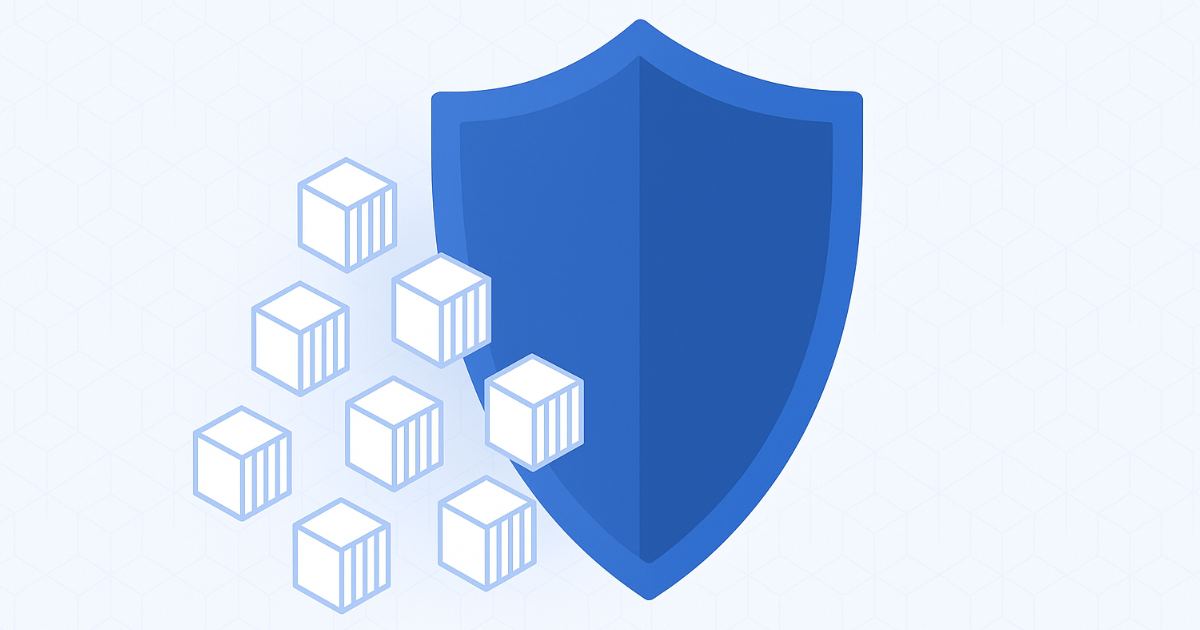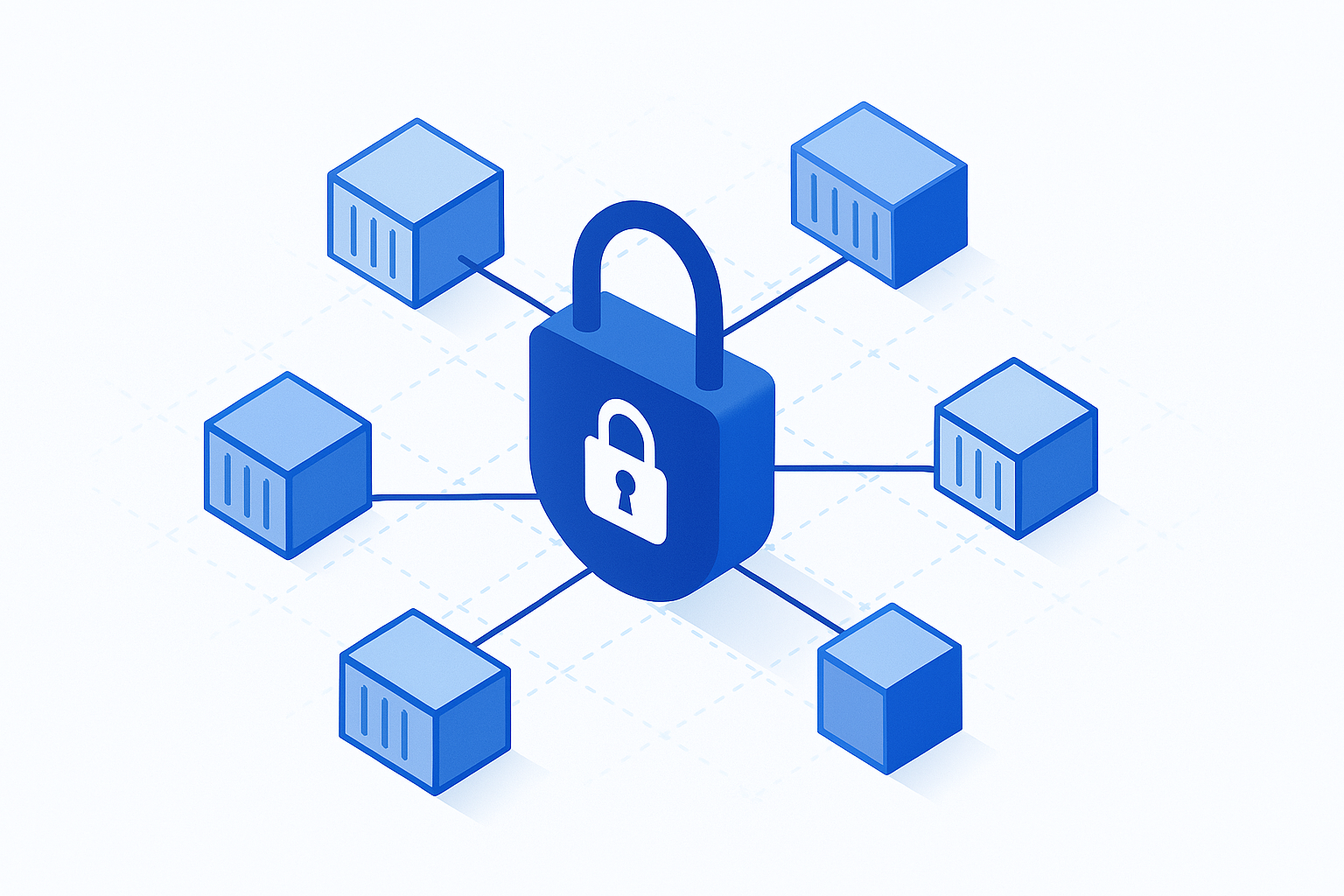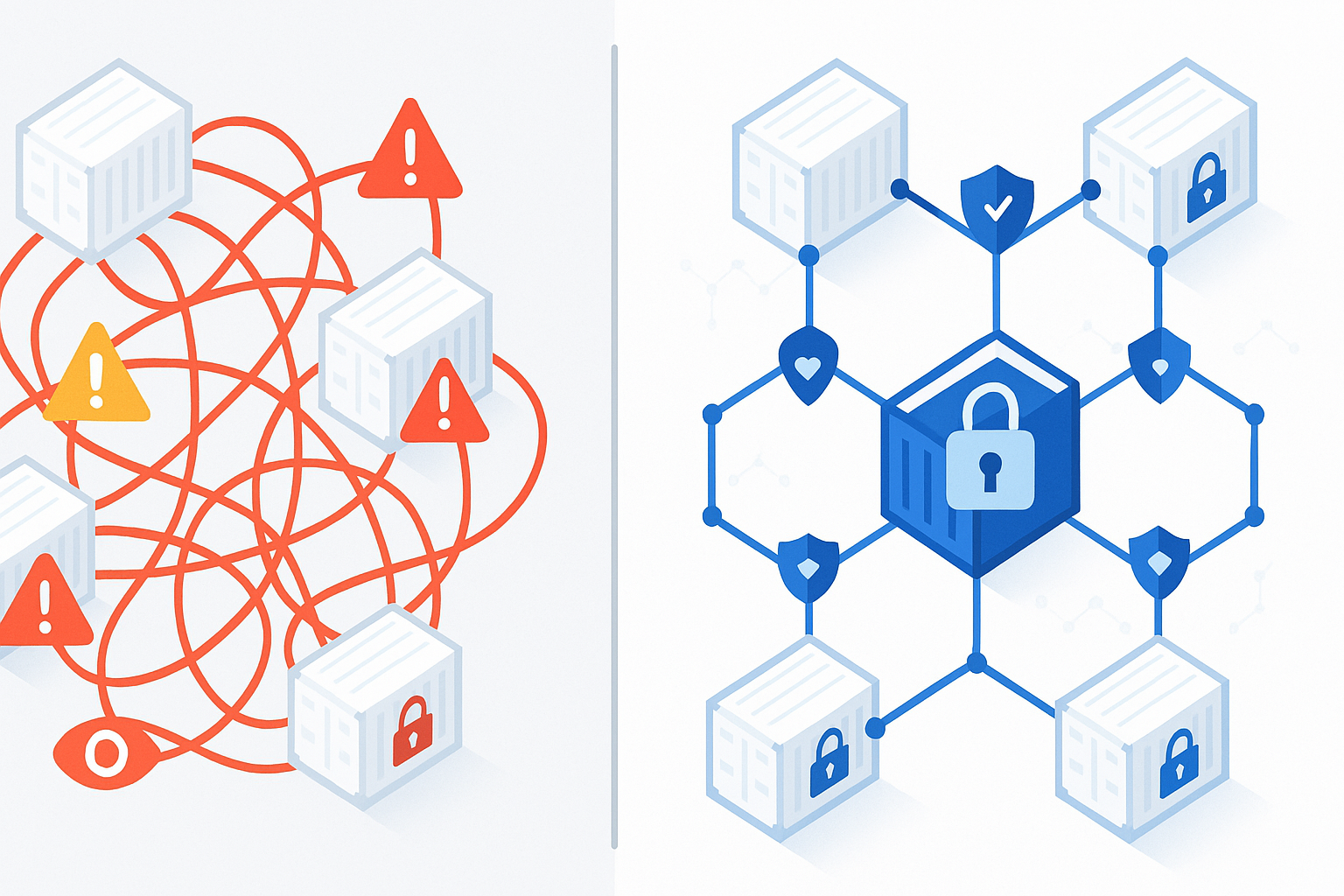
In today's increasingly complex threat landscape, the traditional perimeter-based security model is no longer sufficient. With microservices architectures, containerized applications, and distributed systems becoming the norm, organizations need a more robust security approach. Enter Zero Trust security: a model that operates on the principle of "never trust, always verify."
But implementing Zero Trust in containerized environments can be extraordinarily complex – unless you have the right tools. This is where Convox can dramatically simplify your security implementation while maintaining enterprise-grade protection.
The Challenge: Security in Modern Containerized Environments
Containerized environments present unique security challenges:
- Expanded attack surface due to numerous microservices and communication paths
- Dynamic infrastructure that constantly scales up and down
- Complex network policies required to secure service-to-service communication
- Identity and access management across dozens or hundreds of services
- Secret management for distributed application components
- Compliance requirements that must be maintained despite infrastructure fluidity
Organizations often struggle to implement proper security controls while maintaining development velocity. Manual configuration of network policies, IAM roles, and secrets management can lead to reduced productivity or, worse, security gaps from misconfiguration.
Zero Trust Principles for Containerized Applications

Before diving into implementation, let's review the core principles of Zero Trust security as they apply to containerized environments:
- Verify explicitly - Authenticate and authorize based on all available data points
- Use least privilege access - Limit user access with Just-In-Time and Just-Enough-Access
- Assume breach - Minimize blast radius and segment access with network isolation
Implementing Zero Trust with Convox: A Practical Guide

Convox provides built-in capabilities that make implementing Zero Trust security straightforward. Here's how to put these principles into practice:
1. Secure Service-to-Service Communication
services:
api:
internal: true
port: 3000
web:
port: 8000
resources:
- api
By setting internal: true for your backend services, Convox automatically restricts access to these services from the public internet. Only other services within your Rack can communicate with internal services, providing network segmentation by default.
What this saves you from:
- Creating and maintaining complex Kubernetes NetworkPolicy resources
- Configuring and debugging service mesh solutions like Istio
- Managing integration between ingress controllers and internal services
- Handling mTLS certificate rotation for service authentication
Business impact:
- Reduces attack surface by preventing direct external access to internal services
- Eliminates misconfiguration risks that could expose sensitive internal endpoints
- Decreases implementation time from days/weeks to minutes
- Allows developers to focus on application logic instead of security plumbing
2. Implementing Network Policy Controls
Convox provides granular network controls through service whitelisting:
services:
payment-service:
port: 3001
internal: true
whitelist: "10.0.0.0/16,192.168.1.1/32"
The whitelist attribute restricts access to your service to specific IP ranges, implementing the principle of least privilege at the network level.
What this saves you from:
- Writing, testing, and deploying complex Kubernetes NetworkPolicy resources
- Creating and maintaining custom iptables or security group rules
- Implementing and debugging Calico network policies
- Managing the interaction between network policies and service meshes
Business impact:
- Provides defense-in-depth by restricting traffic even within your cluster
- Simplifies PCI DSS compliance by enforcing network segmentation
- Reduces the blast radius of potential compromises
- Allows for easy adaptation to changing security requirements without specialized knowledge
3. Managing Secrets and Environment Variables
Convox securely manages sensitive environment variables, preventing them from being exposed in your codebase:
$ convox env set STRIPE_API_KEY=sk_test_abcdefghijklmnopqrstuvwxyz
Setting STRIPE_API_KEY... OK
Release: RFGHIJKLMNO
These values are encrypted at rest and only injected into the containers that need them at runtime, implementing the principle of least privilege for sensitive data.
What this saves you from:
- Setting up and managing external secrets management systems like HashiCorp Vault
- Creating and maintaining Kubernetes Secrets integration
- Implementing encryption for secrets at rest and in transit
- Building custom tooling for secret rotation and management
- Handling access control to sensitive credentials
Business impact:
- Eliminates common security incidents related to leaked credentials in code
- Reduces overhead for security and compliance teams
- Simplifies secret rotation processes during security incidents
- Provides fine-grained control over which services access which secrets
- Maintains complete audit trail of environment variable changes
4. Role-Based Access Control
With Convox's RBAC capabilities, you can implement fine-grained access controls for your team:
# Example permissions policy for a read-only developer
- ResourceType: Application
ResourceName: payment-processing-app
Action: Read
This ensures that team members only have access to the specific applications and actions they need, following the principle of least privilege for human access.
What this saves you from:
- Creating complex Kubernetes RBAC configurations (ClusterRoles, RoleBindings, etc.)
- Building custom authentication and authorization systems for your platform
- Managing service account permissions and credentials
- Developing internal tooling for access management and governance
- Maintaining synchronization between identity providers and Kubernetes
Business impact:
- Reduces the risk of insider threats and accidental changes
- Enables safe delegation of responsibilities to specialized teams
- Simplifies compliance with separation of duties requirements
- Provides clear audit trails for access changes
- Allows seamless integration with existing organizational roles and responsibilities
5. Private Network Isolation
Convox deploys your applications into private subnets by default, providing critical network isolation without any additional configuration:
# This security-first approach is built into Convox's architecture
# No additional configuration required!
What this saves you from:
- Creating and configuring complex VPC architectures with public and private subnets
- Setting up and managing NAT gateways and routing tables
- Implementing security groups and network ACLs
- Continuous maintenance of network infrastructure
Business impact:
- Eliminates weeks of specialized network engineering work
- Reduces ongoing operational costs for network maintenance
- Minimizes attack surface by default, improving security posture
- Simplifies compliance documentation for network segmentation requirements
This private-by-default architecture ensures that your application containers run in private subnets with properly configured NAT gateways, minimizing direct exposure to the internet without requiring your team to become networking experts.
6. Implementing Pod Security Policies
Secure your containers by preventing privileged execution:
services:
web:
privileged: false
This prevents containers from running with elevated privileges, reducing the potential impact of a container escape vulnerability.
What this saves you from:
- Creating and maintaining Kubernetes Pod Security Policies (PSPs) or Pod Security Standards
- Configuring OPA Gatekeeper or Kyverno for security policy enforcement
- Building custom admission controllers for security validation
- Managing security policy exceptions and overrides
- Keeping up with Kubernetes security best practices as they evolve
Business impact:
- Drastically reduces the attack surface for container escape vulnerabilities
- Limits the potential damage from compromised containers
- Enforces security best practices without developer friction
- Simplifies security policy documentation for compliance audits
- Reduces the specialized knowledge required to maintain secure configurations
7. Audit Logging and Monitoring
Convox provides comprehensive logging and audit capabilities that are critical for both security monitoring and compliance:
Command Line Logging
$ convox rack logs
2025-04-10T12:34:56Z system/k8s/pod/web-5678 Successfully started container
2025-04-10T12:35:02Z system/auth User john@example.com accessed application payment-app
Exportable Console Audit Logs
The Convox Console provides a full audit trail of all actions taken by users, with filtering capabilities and exportable logs for compliance reporting. This includes:
- User authentication events
- Resource creation, modification, and deletion
- Access to sensitive information
- Administrative actions
- Deployment events
External Integration
These logs can be forwarded to your existing SIEM system using the syslog parameter:
$ convox rack params set syslog=tcp+tls://siem.example.org:1234
What this saves you from:
- Building custom logging infrastructure for Kubernetes
- Creating audit log collection and aggregation systems
- Developing specialized exporters for compliance reporting
- Managing log storage and retention
Business impact:
- Reduces security incidents through improved visibility
- Simplifies compliance audits with ready-to-export logs
- Integrates with existing security monitoring tools
- Provides accountability across teams without additional tooling
Results: Enhanced Security Without the Complexity

After implementing Zero Trust principles with Convox, organizations typically see:
- 80% reduction in time spent managing security configurations
- 50% decrease in security incidents related to misconfigurations
- Near elimination of unauthorized access attempts between services
- Simplified compliance with standards like SOC 2, HIPAA, and PCI DSS
- Faster time to market by reducing security-related deployment delays
- Improved developer productivity by eliminating complex security configuration tasks
- Reduced costs from specialized security engineering resources
- Lower risk profile due to consistent security implementations
Real-World Example: Financial Services Company
A growing FinTech company implementing PCI DSS compliance faced significant security challenges with their Kubernetes infrastructure. Their experience illustrates common issues organizations encounter when implementing Zero Trust principles in containerized environments:
Before Convox:
- Engineers spent approximately 3-4 months configuring and testing Kubernetes network policies, secrets management, and access controls
- Required specialized DevSecOps resources dedicated to container security
- Faced delays in product development due to security implementation complexity
- Struggled with consistent policy enforcement across environments
- Experienced recurring security issues from misconfiguration
After migrating to Convox:
- Implementation time reduced significantly, with security controls configured within weeks
- Improved security posture through consistent network segmentation and least-privilege defaults
- Streamlined compliance documentation and verification process
- Developers maintained productivity with simplified security interfaces
- Reduced operational overhead for security maintenance
Getting Started with Zero Trust on Convox
Implementing these Zero Trust principles with Convox is straightforward:
- Assess your current security posture - Identify your most critical services and data
- Implement service isolation - Mark internal services appropriately in your
convox.yml
- Configure network policies - Use whitelists to restrict communication paths
- Set up RBAC - Define appropriate roles for your team members
- Enable audit logging - Configure log forwarding to your security monitoring systems
Secure Your Infrastructure Today
Don't wait for a security incident to implement Zero Trust principles. With Convox, you can enhance your security posture without the complexity normally associated with containerized security.
Calculate Your Potential Savings
Based on feedback from our customers and industry benchmarks for DevSecOps implementation, organizations implementing Zero Trust with Convox can realize efficiency improvements in these areas:
- Engineering time for initial security implementation: Organizations typically report 60-80% reduction in setup time compared to manual Kubernetes security configuration
- Ongoing security management: Automated security controls can reduce weekly maintenance by approximately 10-15 hours per environment
- Infrastructure complexity: Reduction in specialized security tools and integration points
- Time-to-market: Accelerated deployment cycles due to pre-configured security controls
Take the Next Step
Sign-Up & Get Started Free →
Or contact our security experts for a personalized consultation on implementing Zero Trust architecture for your specific use case.
This blog post is part of our security best practices series. For more information on securing your containerized applications, check out our documentation on RBAC, Private Networks, and Secure Deployments.




